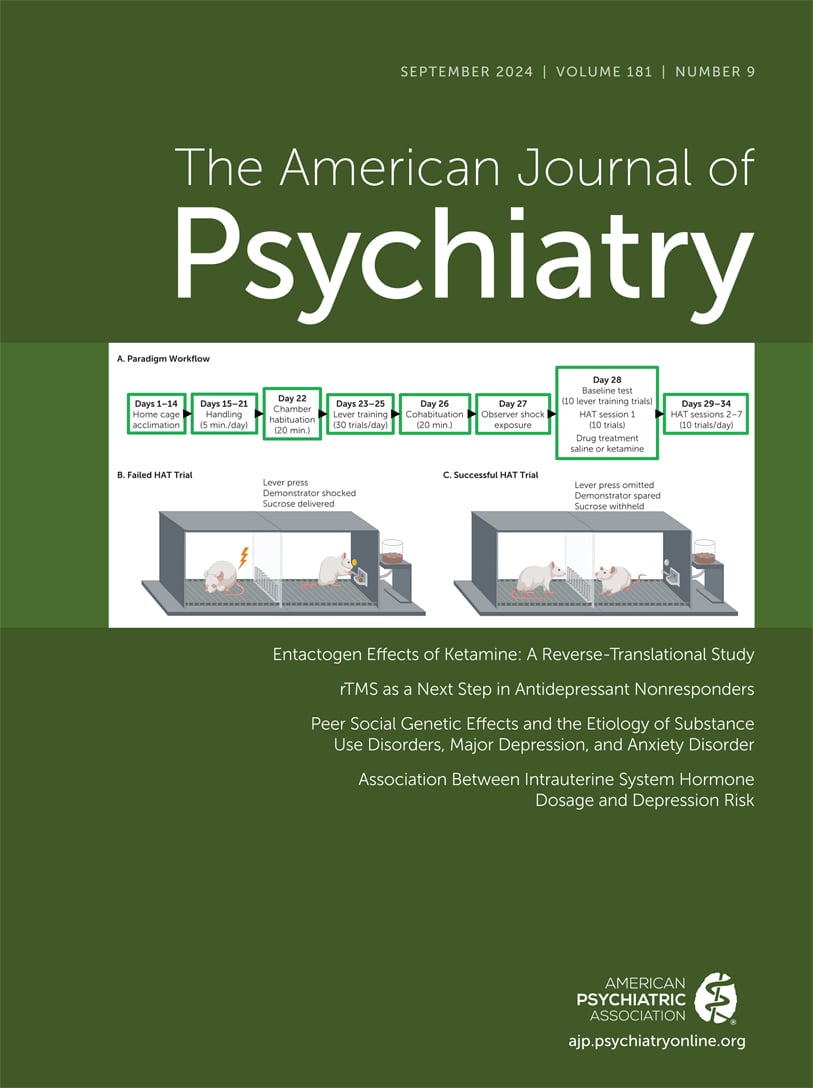In this issue, Schwippel and colleagues (
1) report on the first application of individualized closed loop transcranial alternating current stimulation (tACS) for depression. Transcranial electrical stimulation (tES) has a long history of use for depression, with the first randomized controlled trials conducted in the 1960s (
2). The technique has several relative advantages compared to transcranial magnetic stimulation (TMS), including its enhanced safety profile, reduced costs, and suitability for home use. In the early 2000s, tES saw a research resurgence driven by technological and scientific advances that resulted in rapid gains in understanding about the technique’s neurophysiological mechanisms and associated brain effects. Correspondingly, there was renewed interest in tES for depression, which led to the current evidence base comprising multiple large randomized controlled trials (
3). However, unlike electroconvulsive therapy (ECT) and subsequently TMS, tES was never cleared by the Food and Drug Administration for depression. Possible reasons include reduced efficacy relative to standard pharmacological treatment (
4) and negative findings from multicenter clinical trials (
5).
While the current evidence base for tES for depression primarily comprises the application of a direct electrical current to the brain (i.e., transcranial direct current stimulation [tDCS]), there has been very limited research investigating the efficacy of administering biphasic electrical currents (i.e., tACS). Both tDCS and tACS techniques involve the application of a subthreshold electrical stimulus, although instead of producing polarization effects with a constant unidirectional electrical current, tACS instead involves oscillating modulation of resting neural membrane potentials that can be matched to the brain’s neural activity. In a prior study, the current investigator team showed that administering a single session of tACS at an individualized frequency matched to that person’s resting state alpha (8–12 Hz) frequency could reduce the level of this activity following stimulation compared to placebo (
6). It is interesting that the individual alpha peak frequency (IAF) has been proposed as a biomarker for depression, with a recent study showing that low or high IAFS has potential to assist with guiding allocation to treatments including sertraline, TMS, and ECT (
7).
In the current pilot study, the investigators individually adjusted the frequency of tACS to each participant’s IAF on a daily basis and triggered periods of IAF tACS to occur during heightened periods of alpha activity. This in effect “closed the loop” with tES neuromodulation. By continuously targeting and modulating each participant’s alpha frequency cortical oscillations in the prefrontal cortex across repeated treatment sessions, the investigators’ aimed to produce a cumulative reduction in neural oscillatory activity via homeostatic mechanisms. Indeed, over the 5-day intervention, there was an overall reduction in alpha frequency brain activity, which was associated with mood improvement following treatment. This triggering of brain stimulation via continuous online monitoring has similarly been applied using deep brain stimulation in a patient with depression, with evidence suggesting rapid and sustained mood improvement (
8). IAF tACS, however, has far broader translational clinical potential due to the much reduced safety risks and costs.
While the current findings provide preliminary evidence that “closing the loop” may improve tES antidepressant effects, a number of issues remain to be addressed in future research. First, it is unclear which aspects of the tES parameter space benefit from, or require, real-time monitoring and individualized adjustment. Although alpha has shown promise as a frequency target, other frequency bands, such as frontal theta (4–8 Hz), have also been implicated in depression (
9) and may yield more favorable neuromodulatory effects and improvements in depressive symptoms. Indeed, a form of rTMS designed to mimic theta-gamma phase-amplitude coupling brain activity, called intermittent theta burst stimulation (
10), has demonstrated robust antidepressant effects (
11).
Schwippel et al. (
1) sought to deliver tACS when an individual’s alpha frequency power exceeded a daily threshold without considering the phase of the brain’s ongoing oscillatory activity. Phase-locking the tACS stimulus in-phase or anti-phase to ongoing brain activity may further facilitate entrainment or enhance the brain’s homeostatic response to stimulation. Supporting this view, other brain stimulation techniques, such as rTMS, have shown that such state dependence may explain a substantial proportion of variance observed in acute neuromodulatory effects, with stimuli phase-locked to the trough of alpha-band brain activity leading to greater brain response (
12).
It is not clear whether a closed-loop stimulus ought to match the selected frequency target or endeavor to shift the frequency to a higher or lower value. For example, in a study investigating rTMS to treat depression, higher baseline IAF values were associated with improved clinical outcomes (
13). Therefore, it is reasonable to consider whether “speeding up” alpha activity using tACS may improve antidepressant effects.
Beyond these questions of parameter optimization, the safety of multiple, repeated treatments must be addressed prior to clinical use, particularly concerning unintended epiphenomenal effects from alterations of alpha or other frequency-specific source generators. Alpha is thought to reflect memory and attention, and it has broad relevance to cognition and behavior (
14). While there may be benefits to depressive symptoms following alpha tACS, an important question remains as to whether there are unintended consequences to other behaviors or cognitive functions. It is also important to determine whether the antidepressant effects of closed loop tACS are comparable to other stimulation modalities. Of interest is the comparative efficacy of tACS relative to tDCS, which has been extensively investigated in multiple sham-controlled clinical trials.
In summary, the study by Schwippel and colleagues (
1) serves as an interesting initial foray to explore a new individualized tES intervention, which potentially may show enhanced therapeutic outcomes for depression. We look forward to the further exploration of this technique for depression and other potential clinical indications.

